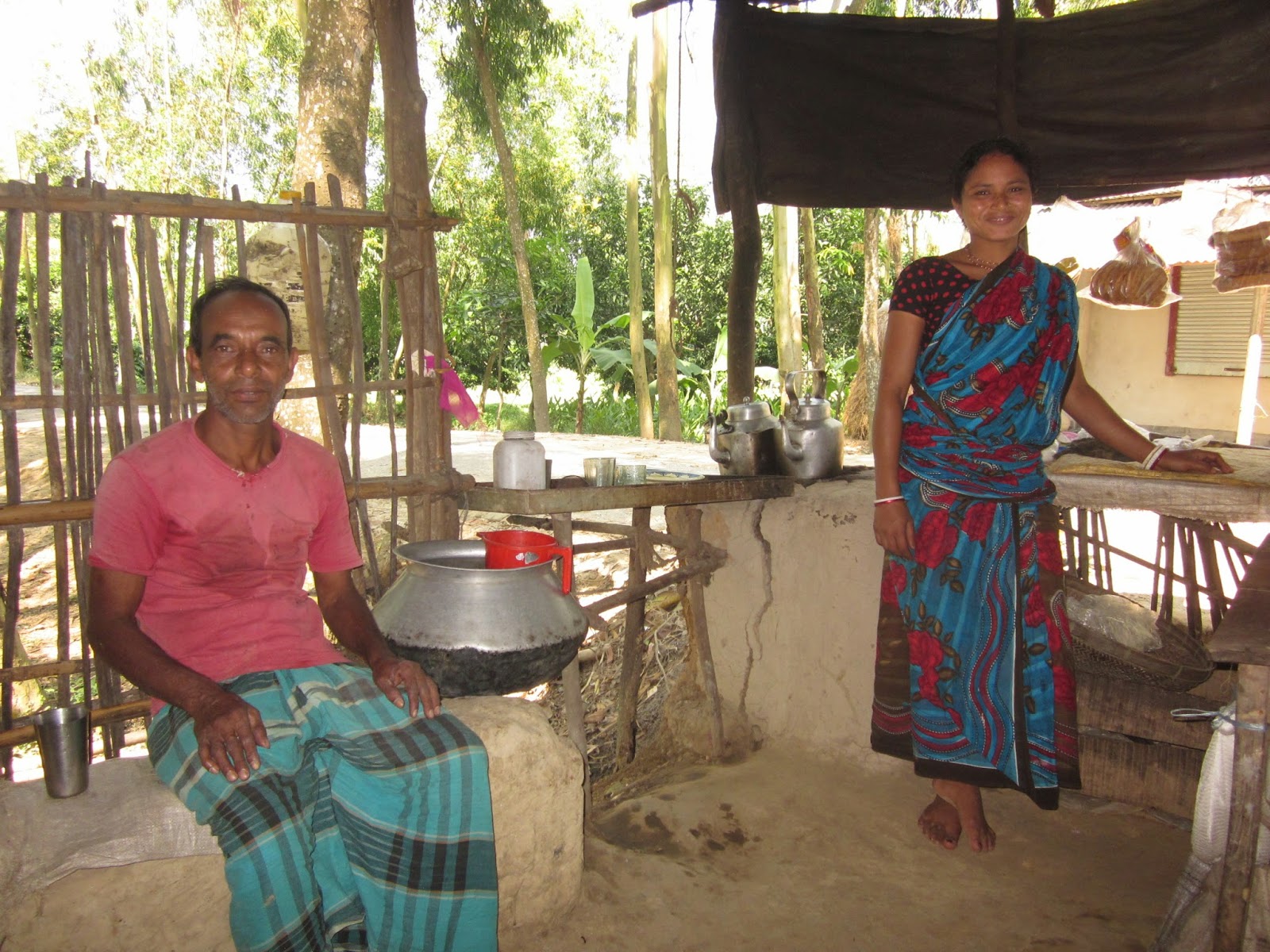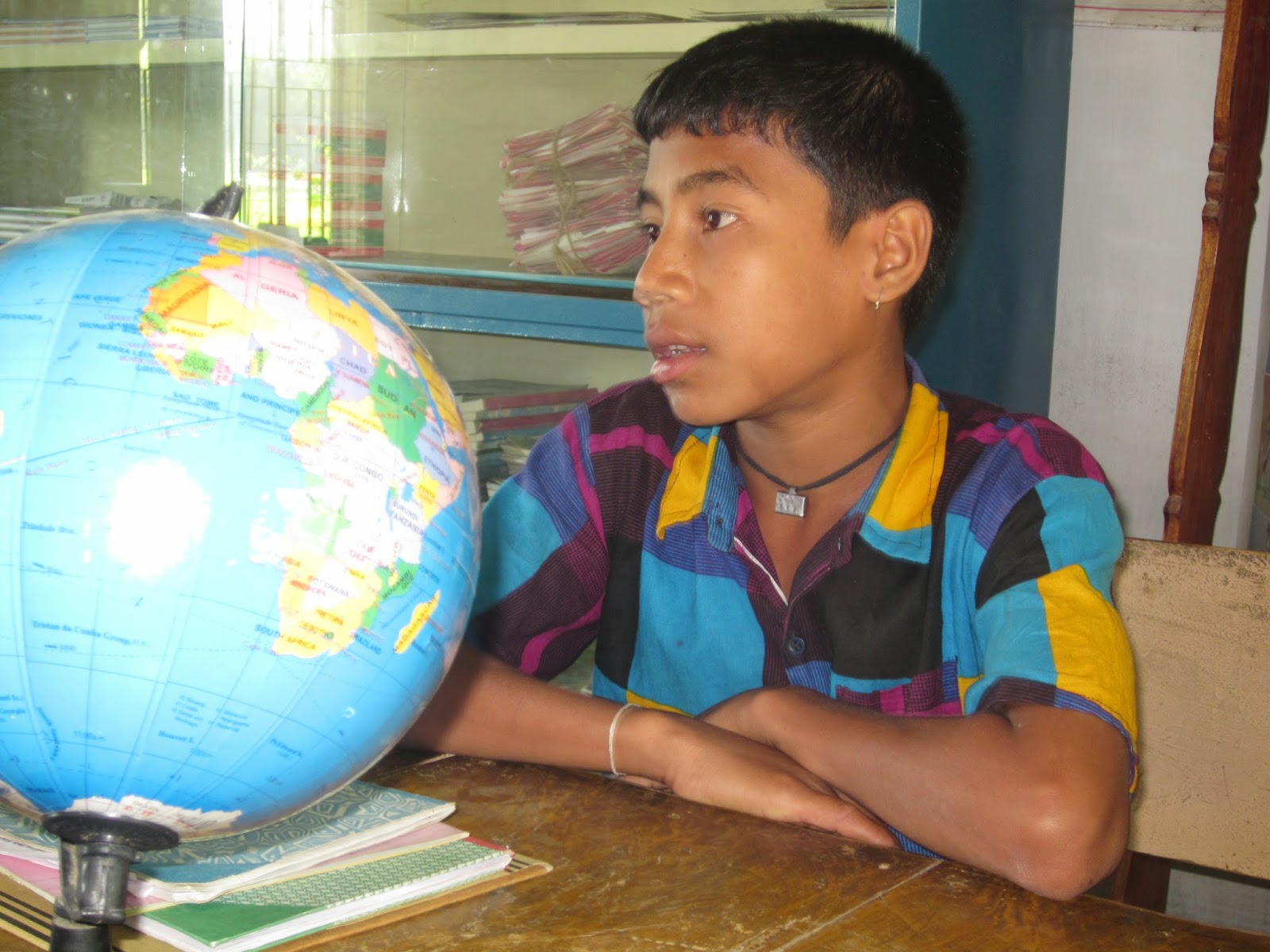 |
| Class 5 student Mosammad Dilara Khatun doesn't like to remember what happened last May. |
 |
| Dilara, trying to explain what happened. |
If you ask my judgement the adults spoke sincerely. However, it was when the children spoke, when terror overtook their faces and they were on the verge of tears…
I wouldn’t have believed it… But in Dharmapur of Dinajpur’s Biral Upazila, surely enough, something happened…
To
find any scrap of Bangladeshi countryside that’s unpleasing to the eye would be
difficult. Dharmapur is particularly charming. The road winds alongside a
brook, passing in and out of stands of sal – the archipelagic edges of the
Dharmapur Forest that nudges the Indian border.
Being
in the tea shop game, entrepreneur Shyama Barman can scarcely miss any goings
on in Dharmapur. Her stall should win an award for its minimalist architecture.
The mud stove is matched by neat, mud benches – a rarity nowadays; a
strategically stretched cloth covers the sun’s glare and the open walls invite
any breeze. Meanwhile the laidback lattice along one side serves to define the cosy
space. It’s uncommon to find a tea stall as beautiful.
“Of
course I was scared,” she says, remembering last May, “but the shop stayed
open.”
 |
| It's unusual to find a tea stall as beautiful as Shyama Barman's. |
The
day is bright. Farmer Mohammed Anwar is, for the moment, Shyama’s customer –
and her tea is equally award-worthy. “They went to school as usual,” he says, “Then
suddenly they felt delirious. It was like that for about a month. It’s never
happened before.”
Dharmapur
Government Primary is not a hundred yards from Shyama’s stylish village enterprise.
It’s an ordinary two-storey building – particularly clean and decorated with painted
illustrations of English and Bangla letters, of fish and jackfruit, of portraits
of Tagore and other inspirational folk. It has four teachers for the 300
students studying in classes one to five.
In
front of the main gate is a small temple. It’s empty now. The gate is locked. Since
May only the side gate is used.
“There
are big trees in the forest,” offers Anwar as he finishes his tea. “People
hardly go to the deepest places.” He speculates that the bhoot in question, the
supernatural spirit believed to have haunted the school, may have lived in an
old tree, as bhoots are often thought to do.
“Or
it was living in the temple,” suggests Shyama.
 |
| Dharmapur Government Primary is clean and brightly painted. It's not at all spooky. |
 |
| Principal Madhab Chandra Barman, 42. |
In
the school’s office, it’s teacher Mosammad Akhija Sultana who greets us. “The
students used to relieve themselves at the side of the temple,” she soon
explains. “We think something happened.”
The principal, who arrives shortly, is Madhab Chandra Barman, a youthful 42-year-old eager to share his experience. “It was early morning when it started,” he says, “There was a World Vision programme before school. I was at home getting ready when I got a message to come quickly. Within two minutes I was here.”
He
found 11-year-old class 5 student Mosammad Dilara Khatun in a state. She was
complaining someone was beating her on the cheeks. She said she’d seen an old
man in white dhoti walking towards her, and after he sat beside her he started
the beating. “She was in the classroom,” says principal Madhab, “Nobody was
beating her.”
 |
| Like his father and grandfather, Toroni Barman dabbles in exorcisms. |
Dilara
was inconsolable. Not knowing what to do Madhab called 81-year-old Toroni
Barman. In Dharmapur it’s dhoti-wearing Toroni who, like his father and
grandfather before him, is known to specialise in exorcisms. “I’ve treated
many,” Toroni says, “but never at a school.”
With
a sprinkling of panipora holy water,
with the smoke of incense and mantra recitation, Dilara’s state returned to
normal, at least temporarily.
“The
next day,” says the principal, “Rebekah was affected. Then Masuma. Then Rita.
Then Lija. Then Firoz.” Over several days, eight class 5 students displayed the
same symptoms. “They all saw the man in dhoti,” says the principal. “As he left
them another saw his approach.”
 |
| Dharmapur Government Primary, Biral, Dinajpur. |
Each
day Toroni exorcised. Each day one student’s symptoms dissipated. Only Dilara
would suffer, sporadically, throughout.
“Firoz
is very strong,” the principal thinks to add. “When he was affected he was
beating himself. He was shouting, ‘Somebody is beating me!’ Ten to twelve
students with the teachers couldn’t control him.”
 |
| Sree Aapon Chandra Barman, 12, faced the bhoot last. His symptoms were different. |
Then
the principal lowers his voice – it’s as if he’s unsure whether to say the next
part, for fear of its meeting disbelief. “It’s strange but when the girls were
saying they were being beaten, afterwards we could see finger imprints on their
cheeks.”
The
principal called the Education Department. “There’s no such thing as a bhoot,” his
seniors said. They sought to arrange a counsellor but the problem wouldn’t wait.
 |
| A bhoot is a creature of the air, says Toroni Barman. |
“A
bhoot is a creature of the air,” says Toroni. “It’s difficult to understand where
they’ll go, where they move. There was a bhoot roaming here.”
On
the last day of the anomalies it was Sree Aapon Chandra Barman who was affected
– but his symptoms were different. In the first-floor classroom, quite suddenly
he raised his hands behind his head in the shape of a cobra’s hood. He started
swaying, snake-like.
Toroni
was called. “What do you want?” he demanded of Aapon.
“The
children are relieving themselves on me,” twelve-year-old Aapon replied. “It
has to stop!” With these words Aapon ran to the balcony and, in front of all, he
jumped!
Uninjured,
Aapon ran across the yard to the main gate, to the temple outside – and beside
it he fell down, losing consciousness.
This
time Toroni exorcised not only Aapon but the entire school grounds. The front
gate was locked. Nobody passed the temple anymore. Everything, finally, returned
to normal.
 |
| Rumana Aktar Lija was one of the students who met the bhoot. |
“The
bhoot isn’t here now,” says Toroni. “It went somewhere – it’s difficult to say where.
But I doubt it’ll return.”
As
word spread most students had stopped attending school. “The area was in
panic,” says Madhab. “Parents worried what might happen to their children. I
had to go house to house to convince each family – it wasn’t easy – that the
situation was normal again.”
Dilara,
Lija, Aapon. I shouldn’t have asked, I shouldn’t have asked! One by one, as
they recount what they can, fear takes hold. “I saw a man in dhoti…” says Lija.
“He caught me and took me to the temple,” says Aapon, who doesn’t remember
jumping. “He was slapping my cheeks,” says Dilara.
 |
| Mosammad Dilara Khatun with her father Mohammad Dulal. |
Unlike
the others, the bhoot also attacked Dilara at home. “We’ve always lived here,”
says farmer Mohammad Dulal, her father. “We’ve never had a problem so when she
first said there was an old man in the room I got angry. I didn’t believe her.
But after some time… I saw her fear. It was real. She really was seeing
something…”
No comments:
Post a Comment